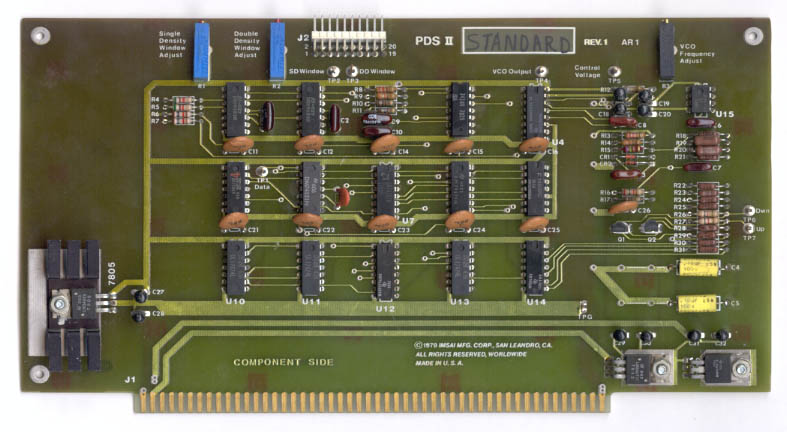IMSAI PDS-II Support


The PDS-II is a floppy disk data separator for use with the DIO-C, DIO-D, and DIO-E controllers.
It replaces the previous generation PDS board with improved reliability.
There are two flavors of PDS-II boards, the PDS-II S (shown here) for 8-inch drives and the PDS-II M for 5¼" drives.
Eight capacitor values determine the flavor.
At the top of the board to the right of the DIO header and PDS II legend is a rectangular void in the solder mask outlined
in the silkscreen where production would hand-write STANDARD for the PDS-II S or MINI for the PDS-II M.
If the flavor was not written in, you can tell by looking at the value of C4 and C5 in the lower-right corner.
Standard boards use 0.1µF while mini boards use 0.22µF.
The data separator was designed around the 74LS124 dual voltage-controlled oscillator, although only one VCO was used.
Shortly after the 74LS124 was used in this design, Texas Instruments released the 74LS624 thru 74LS629 VCOs,
of which the 74LS629 was to be the 74LS124’s replacement. To my knowledge, no one has tested the PDS-II with a 74LS629.
As the PDS-II was one of the last projects to be completed by IMSAI engineering,
it is quite possible that no formal IMSAI documentation exists.
After the demise of IMSAI, it appears the PDS-II was acquired by Fulcrum Computer Products in their 1981 catalog.
The only known copy of the schematic is here,
which is the original draft by Robert E Weatherford, the IMSAI engineering technician who brought the project to production.
There is an omission in the schematic: in the notes, it states “C4, C5 are”. It should have added the word “polycarbonate”.
We may have the original test procedures used by production in our IMSAI archives.
While it is unlikely that a PDS-II will need any adjustments, we would like to provide them for the sake of history.
Project History
This section is the personal recollection of Robert Weatherford on 16-Jan-2021 (the 42nd anniversary of the drafting of the PDS-II schematic).
Joe Killian handed the project over to me in either December 1978 or January 1979 to get it ready for production.
These activities included drafting the schematic, assigning IMSAI part numbers to and qualifying the new parts
(there were many, because IMSAI had not used ±1% resistors or polycarbonate capacitors before),
creating a test hardware jig out of a PIO, and writing 8080 assembler test software for production.
On a personal note, in October of 1978, I moved from my previous position as a production test technician to the
engineering technician position vacated by Gordon Stitt.
Gordon had decided to leave IMSAI (and pursue an MBA as best as I recall) and told me that he would recommend me to
Glen Ewing (the chief engineer) to take his place. He went on to start Extreme Networks several years later.
By April of 1979, the engineering department closed and I returned to production.
It was at that point I realized that IMSAI was probably not going to survive and I left for Dallas Texas to work for Mostek.
At the time, I had assumed that the board was designed by Joe Killian.
He went over the design with me in a fair amount of detail.
I specifically remember the discussion of the separate analog and digital grounds,
which was a popular design practice at the time.
However, this idea conflicts with Thomas “Todd” Fischer’s recollection as chronicled in
Herb Johnson’s Discussion of Early CP/M and IMDOS.
In the article, Todd states that a “very gifted engineer who worked under Glen Ewing”
designed the PDS-II and the RAM III. This engineer’s name was Barry Davis.
I don’t remember working with Barry on the PDS-II, but I do remember many interactions with him regarding the RAM III.
It is certainly possible that Barry was the primary designer, and Joe became my contact point because
Barry was probably busy on something else at the time.
|